Televisions have become a premium source of entertainment for families worldwide. Generally, people install their TVs indoors. But did you know you can enjoy the benefits that come with a TV outdoors?
Mounting a TV outside can be tricky, but it’s ultimately straightforward as long as you know what to do. Today’s article will inform you of what you need to know before mounting your screen outdoors. Let’s get started!
Outdoor TV Mounts: Overview and Types
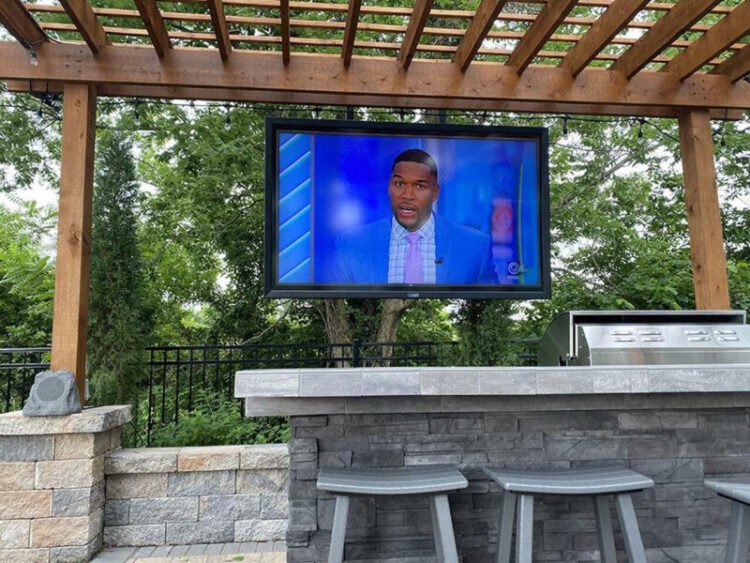
An outdoor TV mount is intended for outdoor use. Since outdoor televisions are typically heavier than their indoor counterparts, outdoor mounts are typically stronger and better designed to support their weight.
Different Types of Outdoor TV Mounts Available
Wall-Mounted Outdoor TV Brackets
These wall mounts are the perfect choice for achieving a low profile, stylish, ultra-sleek design. Wall-mounted outdoor brackets are easy to install and have the ability to hang a television flush against the wall.
Ceiling-Mounted Outdoor TV Mounts
The ideal option for attaining a low profile, fashionable, ultra-sleek appearance is a wall-mounted bracket. Wall-mounted outdoor brackets are easy to install and can hang a television flush against the wall.
Articulating and Tilting Outdoor TV Mounts
An articulating or tilt mount lets you change the TV’s viewing angle for the ideal experience. This bracket allows the television to be adjusted to reduce glare and enhance your viewing experience, making it a fantastic option for rooms that get direct sunlight during the day. Get more information on the other TV mounts here.
Outdoor TV Considerations
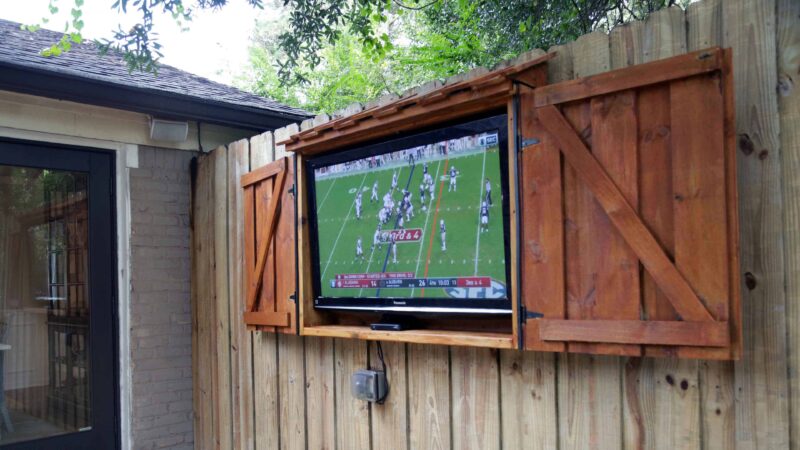
Weatherproofing and Durability
Water and Dust Resistance Ratings
Ensure you verify the product’s weather rating before making your new TV purchase. The IP (ingress protection) rating of an electrical item tells you how effective the seal is. An example of a common outdoor TV IP rating is IP55. The first number indicates its resistance to particles like dust, while the second number represents its resistance to liquids like rain.
Impact Resistance and Protection Against Extreme Temperatures
It’s important to use a TV that will suit the weather conditions in your area. Fortunately, the majority of outdoor TVs offer defense against rain, snow, and humidity. So, review the specifications of the television to ensure it matches the prevalent weather in your region.
Sunlight and Glare Management
Anti-Glare and High-Brightness Screens
Consider TVs with anti-glare functionality and high brightness screens. Fortunately, this capability is included with most outdoor TVs. Finding these features shouldn’t be difficult because they often appear on the TV’s feature list. However, if you’re unsure, call the customer care representative to confirm.
Shading and Positioning Considerations
It’s advisable to install a television outside and place the screen somewhere shaded. Shaded areas will ensure a better overall performance of the TV. Face the TV southward if you don’t have access to an awning, gazebo, or eave for shade. A north-facing installation should be avoided because the LCD display will be facing the sun, thereby making it difficult to view.
Connectivity and Cable Management
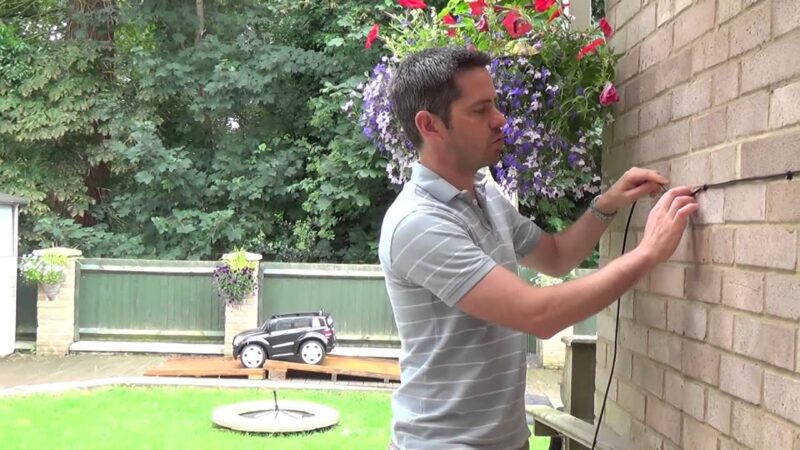
Outdoor-Rated Cables and Connectors
Consider adding protective elements to your wires and plug-in accessories. Ensure you have an IP-rated power point installed by a certified electrician if you are connecting the TV to a power point that is outside and subject to weather.
Concealing Cables and Wiring for Aesthetics and Safety
An effective way to beautify the area around your outdoor TV is to hide external wiring. Wires that hang or run over the floor can cause tripping hazards and even pull large units away from the wall, destroying the surrounding area’s furniture or endangering people. For this reason, ensure you finish off the installation and conceal the cables.
Location and Placement
Assessing the Outdoor Space and Viewing Angles
Mounting your TV outdoors can be challenging. So, before choosing where to position your TV, we advise checking the outdoor conditions so you can find the perfect spot to place the TV.
Mounting Options Based on the Location
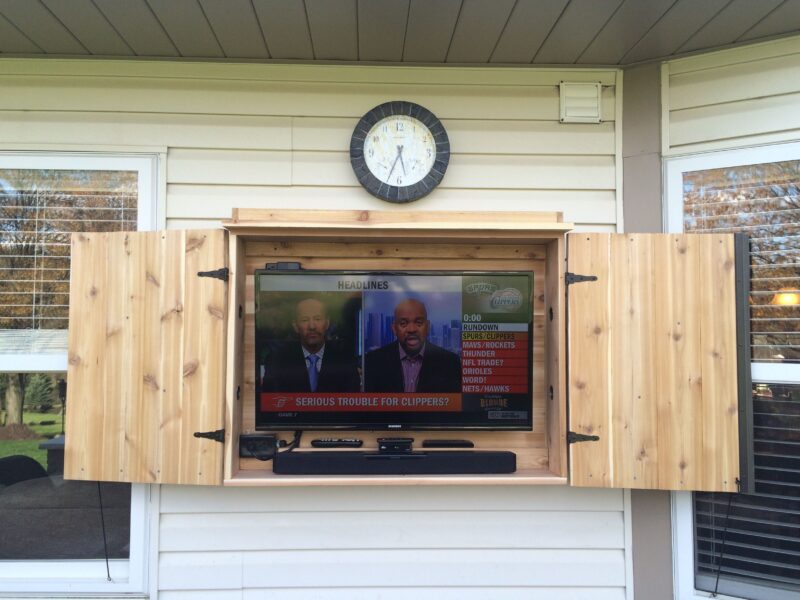
If you decide against using a cabinet enclosure for your TV, ensure you install the TV somewhere that is shaded from the sun, such as below a porch, or patio.
The most popular option is an existing wall because it gives you a robust structure that shouldn’t need additional fastenings.
Post-mounted options are another option if you don’t have a suitable wall or can’t locate the proper angle, but they involve more work on your part. You can also choose a ceiling mount and use a ceiling pole bracket if you have an overhanging structure.
Considerations for Sun Exposure, Shade, and Potential Obstructions
A permanent umbrella, awning, or other covering is a good place to put a TV if you want to make sure the screen is always giving viewers the best possible view. Placing the TV beneath a natural or man-made shade allows the screen to remain visible and clear, regardless of the weather. Additionally, it’s critical to put the TV in an open area to avoid any obstructions to your viewing angles.
Height and Viewing Distance Considerations for Optimal Viewing Experience
The size of the TV determines the ideal height at which to hang it. For instance, the ideal mounting height for a 42-inch TV is about 55 inches from the floor to the center of the screen. Furthermore, the recommended TV mounting height for a 55-inch television is approximately 60 inches. Bear in mind that the bigger the screen, the higher the mounting height.
Installation and Setup
Proper Wall or Ceiling Preparation and Mounting Surface
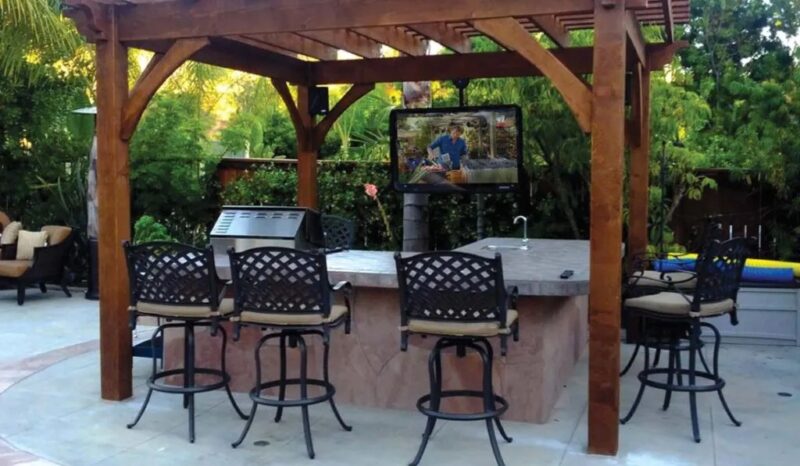
The first step is to determine where the center of the space will be installed for your TV. Mark the central area with a pencil and measure it with a tape measure so you know where to drill.
To determine the location of the TV brackets, measure the back of the TV. This makes it easier for you to decide which part of the wall you want to attach the device to.
Securing the TV Mount and Ensuring Stability
Use a level to check that the mount is correctly horizontal before permanently attaching the mounting bracket to the wall. Next, use a pencil to locate the place where the holes will be drilled after leveling the wall mount. Drill the holes, then insert the toggle bolts.
Next, align the toggle bolts with the mounting bracket. Afterward, insert the screws through the toggle bolts to firmly fasten the mounting bracket.
Routing and Protecting Cables During Installation
Organize your cable connections before installing your TV.
Even though you can manage the cords later, it’s worthwhile to organize them before the TV gets in the way.
Electrical Requirements and Outdoor Power Outlets
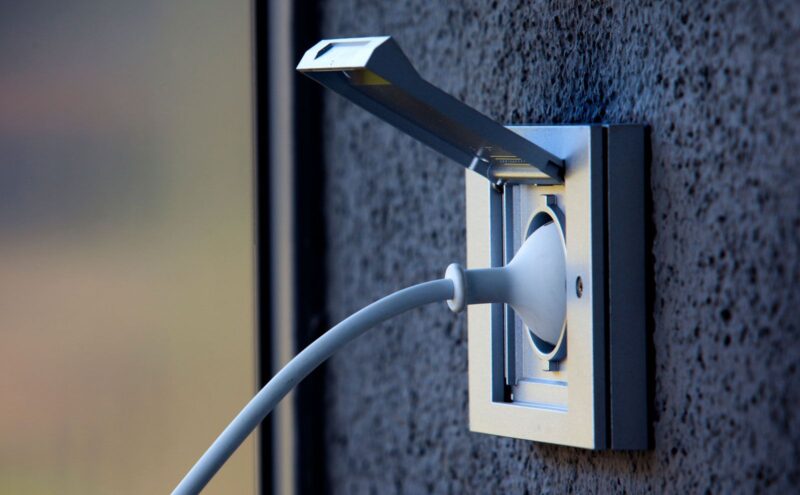
Make sure there is a way for you to plug your TV into a power outlet. You’ll either have to call in an electrician to install a power outlet outside or connect extension cords inside to use outside. Now, place the TV on the wall mount, plug it in, and turn it on.
Calibrating the TV for Outdoor Viewing Conditions
Now that the TV is on, check if the colors and brightness are as vivid as you would like. If they aren’t, navigate to the TV settings menu, select brightness, and adjust it to your preference.
Outdoor TV Protection and Maintenance
Covers and Enclosures for Additional Protection
Installing your TV inside a weather-rated enclosure will protect it from moisture, heat, filth, theft, and vandalism.
Regular Cleaning and Maintenance of the TV and Mount
It’s crucial to schedule regular cleaning for your mount and TV so that dust or moisture won’t damage them. Also check the coaxial cables frequently to make sure that debris isn’t obstructing the signal.
Seasonal Considerations and Storage Options
We always recommend using an outdoor TV cover for the TV since it will be left outside. Weatherproof protection is essential, and don’t forget to cover your outdoor TV after you’re done watching it.
Warranty and Insurance Coverage for Outdoor TVs
Always purchase an outdoor TV with at least a one-year warranty, so you can rest easy and replace it if it develops any factory faults.
Audio Considerations
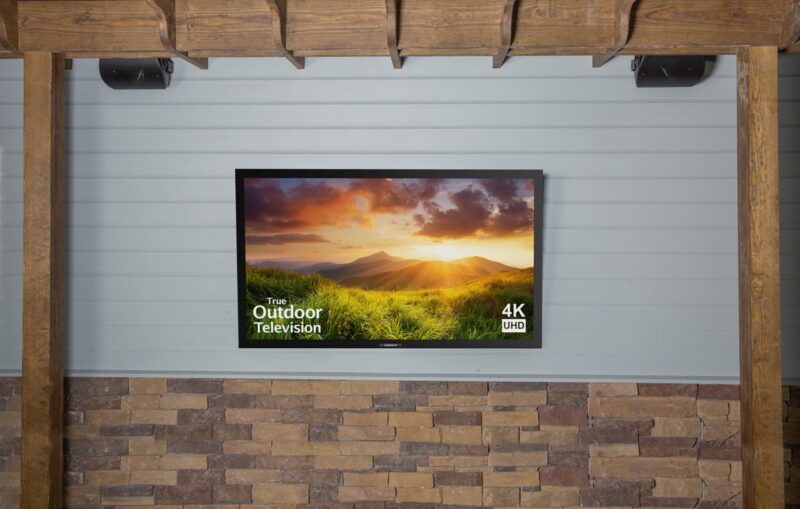
External speakers or soundbar options for improved audio quality
Outdoor Sound Bars
A sound bar is an intuitive and effective way to improve your audio output. You can connect the sound bar directly to your outdoor TV without a home theater receiver.
Bluetooth
You can transmit your TV’s sound output to a Bluetooth speaker if your outdoor TV supports Bluetooth audio streaming. The ability to adjust your sound on the go makes Bluetooth ideal for parties. Lastly, we recommend using weather-resistant speakers and amplifiers for your outdoor TV.
Security and Theft Prevention
Anti-Theft Measures for Outdoor TV Security
The last thing you want is for your outdoor TV to be stolen after you spent so much money on it. When installing your television, use a TV security kit to prevent television theft. This kind of anti-theft gadget fastens your television to the wall with a steel cable, discouraging any robbers. Having a tamper-proof mount is also helpful.
You might also want to put in a security camera or motion-activated floodlight for further protection.
Regulations and Permits
Always check in with your local regulations to confirm the necessary permits and documents required for the installation of the outdoor TV.
Conclusion
That’s all there is to know about mounting a TV outside! Pay attention to the considerations listed, and you’ll have the perfect home entertainment setup to keep your family and guests entertained!
